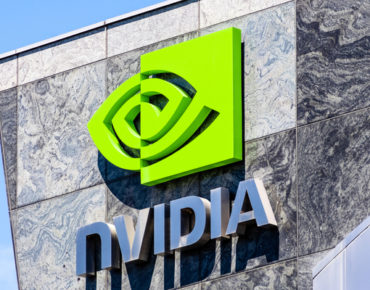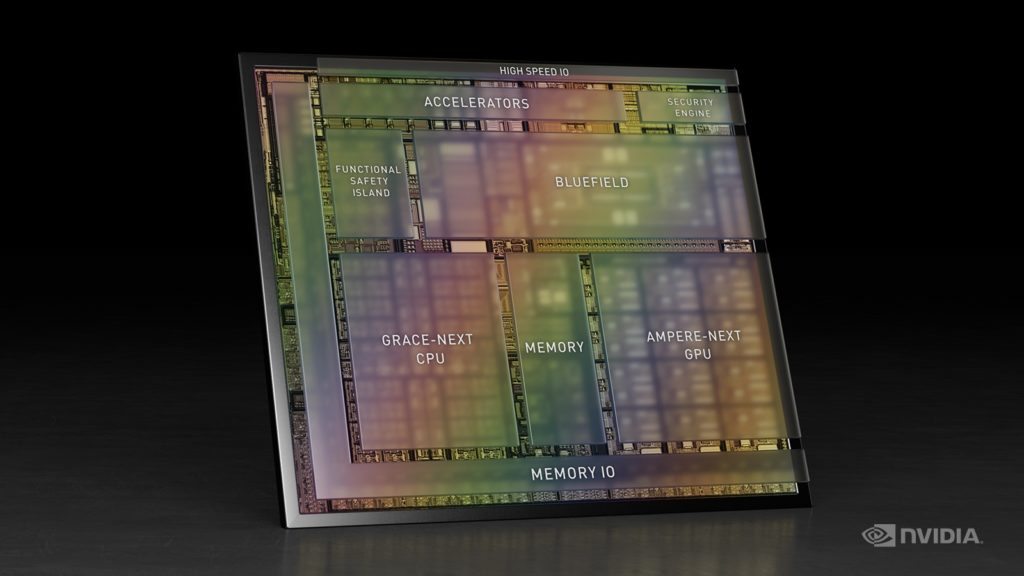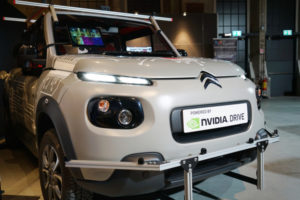Nvidia GTC21 Wrap-up: Nvidia AI and 5G, Autonomous Vehicles and More

Nvidia GTC21 – Here at Nvidia’s virtual spring GPU Technology Conference (GTC) this week Nvidia had big news about its two new AI-targeted GPUs and its all-new Grace data center CPU.
But the company also made a myriad of other announcements about new products and services, from the combined use of AI and 5G to autonomous vehicle technologies, cybersecurity and AI-enabled workflow tools.
In this GTC21 wrap-up, we’ll take a look at some of those new offerings and share Nvidia’s plans for these other technologies.
Nvidia DRIVE Atlan
Melding AI and Nvidia’s BlueField technologies on a single chip, Nvidia DRIVE Atlan is a system-on-a-chip (SoC) built for next-generation autonomous vehicles. Calling it a data center on wheels, Nvidia said that DRIVE Atlan delivers more than 1,000 trillion operations per second (TOPS) and will be ready for use in automaker vehicles for the 2025 model year.
Nvidia DRIVE Atlan is the latest in the company’s road map of autonomous vehicle (AV) chips, which bring together AI and software, computing, networking and security to serve always-increasing AV requirements from carmakers, the company said.
The first generation of Nvidia DRIVE was the Xavier chip, with performance of 30 TOPS. Xavier is found in production cars and trucks today. The next generation of DRIVE chips, called Orin, delivers 254 TOPS and will be used in auto and truck production starting in 2022.
All three generations of DRIVE, Atlan, Orin and Xavier, are programmable through open CUDA and TensorRT APIs and libraries, allowing developers to leverage their investments across multiple product generations as they establish their future AV production roadmaps, according to Nvidia.
The latest DRIVE Atlan architecture includes Nvidia’s next-generation GPU architecture, new Arm CPU cores and the latest deep learning and computer vision accelerators. The architectures allow automakers to build software-defined vehicles that can be re-programed and perpetually upgraded through secure, over-the-air updates, the company said.
“The transportation industry needs a computing platform that it can rely on for decades,” Jensen Huang, Nvidia’s CEO, said in a statement. “The software investment is too immense to repeat for each car.”
The biggest new feature of DRIVE Atlan is its inclusion of an Nvidia BlueField data processing unit (DPU), which brings advanced networking, storage and security services to support complex compute and AI workloads found in autonomous vehicles. BlueField includes data-center-infrastructure-on-a-chip programmability, as well as security features that prevent data breaches and cyberattacks. DRIVE Atlan is designed from the ground up to handle the large number of AI applications that run simultaneously in autonomous machines.
Nvidia DRIVE Orin to Be Used Across Volvo’s Vehicle Line
Also announced at GTC21 was a move by vehicle maker Volvo to use Nvidia’s DRIVE Orin chips and architecture across the company’s full model line.
The use of Orin will start with Volvo’s next-generation XC90 SUV, which will debut in 2022, bringing software-defined autonomous driving to upcoming Volvos.
Volvo has been using Nvidia DRIVE Xavier since 2016 and has been developing AI-assisted driving features for new models with software developed in-house and by Zenseact, which is Volvo’s autonomous driving software development company. Nvidia Orin, which also has a SoC architecture, can handle a large number of applications and deep neural networks that run simultaneously in autonomous vehicles and robots, while meeting systematic safety standards such as ISO 26262 ASIL-D, according to Nvidia.
Volvo will use Orin chips with its own software and with state-of-the-art sensors such as LiDAR and radar to deliver robust AI capabilities and broad safety standards.
DRIVE Orin was first unveiled by Nvidia in December of 2019. Orin can power all the intelligent computing functions inside vehicles, including visualization of autonomous driving capabilities, digital clusters, infotainment and passenger interaction AI.
Orin can be used by automakers to replace tens of electronic control units that are built into today’s vehicles. Instead, by centralizing control and replacing the old-style control units, automakers can simplify their complex supply chains, according to Nvidia.
What’s Up with AI and 5G
Nvidia’s latest AI-on-5G computing platform was also unveiled at GTC21, leveraging the Nvidia Aerial Software Development Kit (SDK) together with the new Nvidia BlueField-2 DPU and Nvidia Ampere CPUs, which are brought together on one card for use on Nvidia-certified servers. Nvidia AI-on-5G also includes the Nvidia EGX enterprise platform and can be deployed and managed on-premises or managed by hyperscalers including Google Cloud.
Huang called the Nvidia Aerial A100 “the most advanced PCI Express card ever created,” bringing together 5g and AI into a new type of computing platform designed for the edge.
As part of the announcement, service and network infrastructure providers including Fujitsu, Google Cloud, Mavenir, Radisys and Wind River are joining with Nvidia to develop a broad range of products and services for the AI-on-5G platform to help promote the creation of smart cities and factories, advanced hospitals and intelligent stores.
The platform can be used by enterprises, mobile network operators and cloud service providers to handle both 5G and edge AI computing in a single, converged platform. Users will be able to use the systems to manage precision manufacturing robots, automated guided vehicles, drones, wireless cameras, self-checkout aisles and hundreds of other projects, according to Nvidia.
Nvidia’s work in the new AI-on-5G ecosystem includes membership in the O-RAN Alliance, which is developing standards for more intelligent, open, virtualized and fully interoperable mobile networks. These collaborations allow operators to use the same computing infrastructure required for 5G networking to provide AI services in enterprise, industrial and consumer and residential settings.
The unified AI-on-5G platform brings together developments in AI and 5G at the edge to accelerate the digital transformation of enterprises across all industries, according to Nvidia.
Nvidia Morpheus Cybersecurity
Powered by Nvidia GPUs and Nvidia BlueField-3 DPUs, Nvidia’s new Morpheus application framework is designed to provide cybersecurity companies with accelerated AI skills that can be used to constantly detect and prevent security threats as they happen, according to Nvidia.
Built as a cloud-native cybersecurity framework, Morpheus uses machine learning to identify, capture and act upon threats and anomalies that are found, including leaks of unencrypted sensitive data, phishing attacks and malware.
“Nvidia Morpheus combines Mellanox in-server networking and Nvidia AI to do real-time, all-packet inspection to anticipate threats and eliminate them as they arise,” said Huang.
Morpheus and the BlueField DPUs enable compute nodes in the network to serve as a cyber-defense sensor at the edge, letting organizations analyze every packet with line-rate speed without data replication, the company said. Traditional AI security tools typically only sample about five percent of network traffic data, leading to threat-detection algorithms based on incomplete models.
Nvidia TAO Workflow-Driven Framework
To make it easier to train, adapt and optimize (TAO) pre-trained deep learning models, Nvidia also announced its new TAO framework at GTC21. Pre-trained models allow users to users to take advantage of the development work of others and get their work started more quickly, which particularly benefits companies that don’t yet have deep related skills.
Users can select from a wide range of pre-trained models in Nvidia’s NGC catalog to make it simpler to design and train their own neural networks with the help of the TAO framework. TAO lets users fine tune models to fit their specific needs.












